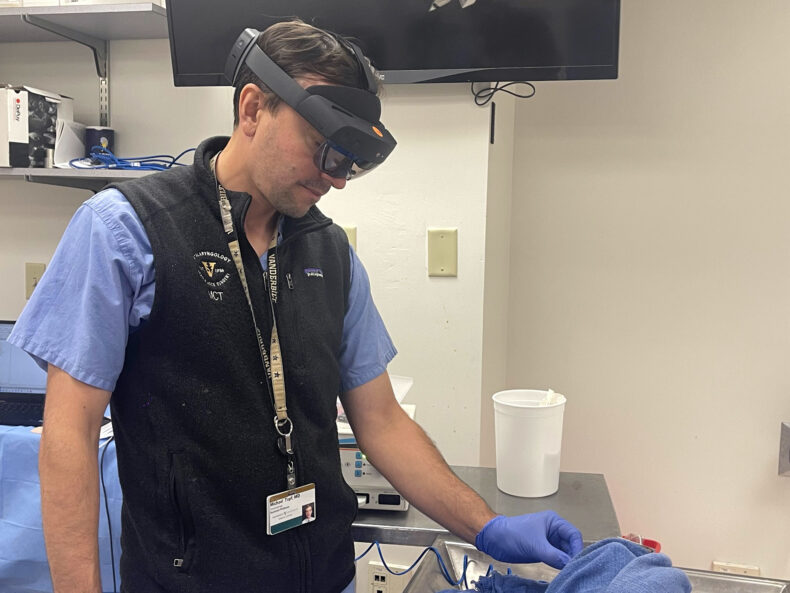
George Washington University biomedical engineering student Sydney Bailes spent her summer carefully creating silicone layers of precise consistencies, and she hopes to spend winter break continuing work on the project that can one day help junior surgical trainees practice a critical skill — inserting surgical instruments for abdominal surgeries.
Understanding the abdomen’s anatomy is crucial to safely inserting a trocar, a long, hollow metal surgical instrument used during laparoscopic surgery, and Bailes was tasked with creating a lifelike abdominal model, complete with every layer: skin, fat, muscle, fascia, pre-peritoneal fat and the peritoneum. The model is intended to give medical trainees practice entering the abdomen with an open technique, as well as experience inserting a trocar through layers that mimic the resistance of actual tissue.
Bailes was assigned the summer internship project by Kyla Terhune, M.D., associate professor of Surgery and director of the General Surgery residency program at Vanderbilt University School of Medicine, and she worked with Nick Carter, M.D., a Surgery resident with a special interest in education.
“When I sat down with Sydney and heard about her goals, it sounded like she would enjoy doing something with medical devices,” Terhune said. “I wanted her to work on something achievable in the short time she was with us, something realistic, but that got her into the hospital so she could observe the clinical side of things.”
Carter knew from experience working with junior residents and medical students that inserting a trocar and knowing just the right amount of pressure to use was something trainees were often uncertain about, and he suggested Bailes address that. While there is available simulation training on using laparoscopic surgical tools, and there are lifelike models for other surgical procedures, there aren’t any realistic models that let students practice trocar insertion, Carter said.
In March 2017, Terhune had met a German surgeon, Ulrich Dietz, M.D., Ph.D., who had developed his own silicone-based abdomen models for practicing hernia repairs and other minor surgeries. She shared information about Dietz’ models with Carter and Bailes, and scheduled Bailes to observe trocar placement during actual surgeries in the operating rooms.
“Much of the teaching on trocar insertion and entry into the abdomen is done in the operating room,” Terhune said. “At the end of their training can our residents safely insert a trocar without a model? Yes! But sometimes using simulation models in education can give people a head start or allay any initial anxiety they might have associated with a specific procedure.”
Bailes researched silicone technology and purchased materials to create the layers. She worked with Operations Manager Jordan Halasz and Simulation Education Specialist Ray Booker at the Vanderbilt Center for Experiential Learning and Assessment (CELA), and the first prototype abdomen was complete by late August.
“Making the simulator was amazing because I got to really go in depth on one topic and physically make a representation of what I had learned,” Bailes said. “It was a valuable experience because I got to oversee a design process from the beginning to the first prototype. I will be able to apply my experiences on this project to any projects I work on in the future.”
Carter and Terhune were pleased with the first model, and they hope another student will create a second prototype during the fall, with Bailes returning on her winter break to assist.
“I’d love to pilot this in February 2018, in preparation for our Surgical Internship Boot Camp course,” Carter said. “That’s when we’ll have everyone together in one group who would really have an interest in learning this.”
Bailes, who is a Clark Engineering Scholar at GWU, returned to college and presented her project to other engineering scholars who “thought it was really cool.
“I enjoyed working with Dr. Terhune because it gave me a perspective on the medical field that I had not been given before,” Bailes said.
“I normally approach biomedical engineering from an engineering perspective that is much more technical. Being able to work in CELA helped me see more of a clinical side, and I learned a lot about medical education and the things that have to be considered when training residents and medical students.”
Bailes is the daughter of VUMC Center for Women’s Health Social Worker Carolyn Bailes and Palliative Care Social Worker Melinda Bailes, who were both thrilled that Sydney was mentored by Terhune.
“As a young, accomplished female engineering student, I knew it would be important for Sydney to work with accomplished women who are dedicated to education and research,” Melinda Bailes said. “Kyla is easy to talk to, and I felt she would really help Sydney learn about the health care aspects of Biomedical Engineering.”

















